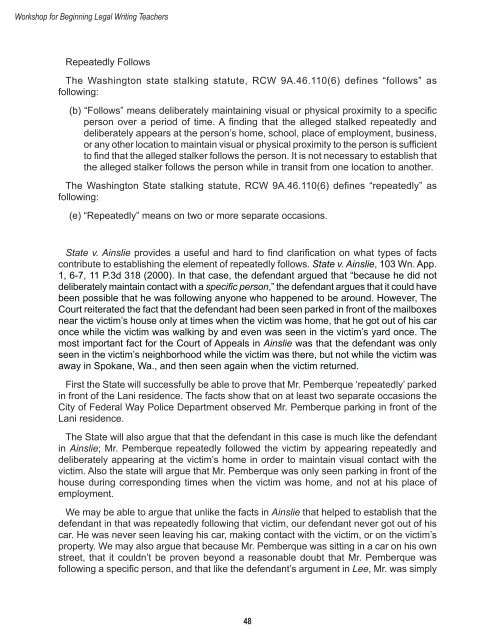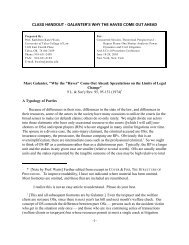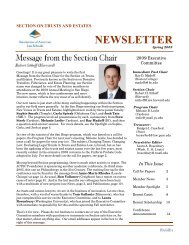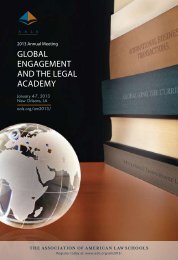Workshop for Beginning Legal Writing Teachers - AALS
Workshop for Beginning Legal Writing Teachers - AALS
Workshop for Beginning Legal Writing Teachers - AALS
Create successful ePaper yourself
Turn your PDF publications into a flip-book with our unique Google optimized e-Paper software.
<strong>Workshop</strong> <strong>for</strong> <strong>Beginning</strong> <strong>Legal</strong> <strong>Writing</strong> <strong>Teachers</strong><br />
Repeatedly Follows<br />
The Washington state stalking statute, RCW 9A.46.110(6) defines “follows” as<br />
following:<br />
(b) “Follows” means deliberately maintaining visual or physical proximity to a specific<br />
person over a period of time. A finding that the alleged stalked repeatedly and<br />
deliberately appears at the person’s home, school, place of employment, business,<br />
or any other location to maintain visual or physical proximity to the person is sufficient<br />
to find that the alleged stalker follows the person. It is not necessary to establish that<br />
the alleged stalker follows the person while in transit from one location to another.<br />
The Washington State stalking statute, RCW 9A.46.110(6) defines “repeatedly” as<br />
following:<br />
(e) “Repeatedly” means on two or more separate occasions.<br />
State v. Ainslie provides a useful and hard to find clarification on what types of facts<br />
contribute to establishing the element of repeatedly follows. State v. Ainslie, 103 Wn. App.<br />
1, 6-7, 11 P.3d 318 (2000). In that case, the defendant argued that “because he did not<br />
deliberately maintain contact with a specific person,” the defendant argues that it could have<br />
been possible that he was following anyone who happened to be around. However, The<br />
Court reiterated the fact that the defendant had been seen parked in front of the mailboxes<br />
near the victim’s house only at times when the victim was home, that he got out of his car<br />
once while the victim was walking by and even was seen in the victim’s yard once. The<br />
most important fact <strong>for</strong> the Court of Appeals in Ainslie was that the defendant was only<br />
seen in the victim’s neighborhood while the victim was there, but not while the victim was<br />
away in Spokane, Wa., and then seen again when the victim returned.<br />
First the State will successfully be able to prove that Mr. Pemberque ‘repeatedly’ parked<br />
in front of the Lani residence. The facts show that on at least two separate occasions the<br />
City of Federal Way Police Department observed Mr. Pemberque parking in front of the<br />
Lani residence.<br />
The State will also argue that that the defendant in this case is much like the defendant<br />
in Ainslie; Mr. Pemberque repeatedly followed the victim by appearing repeatedly and<br />
deliberately appearing at the victim’s home in order to maintain visual contact with the<br />
victim. Also the state will argue that Mr. Pemberque was only seen parking in front of the<br />
house during corresponding times when the victim was home, and not at his place of<br />
employment.<br />
We may be able to argue that unlike the facts in Ainslie that helped to establish that the<br />
defendant in that was repeatedly following that victim, our defendant never got out of his<br />
car. He was never seen leaving his car, making contact with the victim, or on the victim’s<br />
property. We may also argue that because Mr. Pemberque was sitting in a car on his own<br />
street, that it couldn’t be proven beyond a reasonable doubt that Mr. Pemberque was<br />
following a specific person, and that like the defendant’s argument in Lee, Mr. was simply<br />
48







